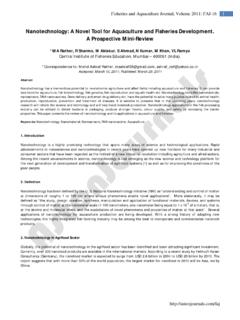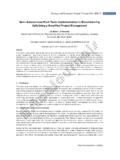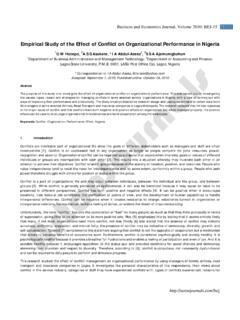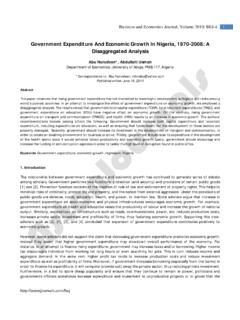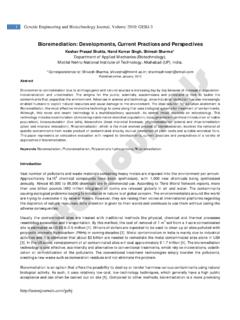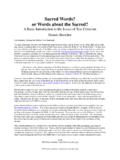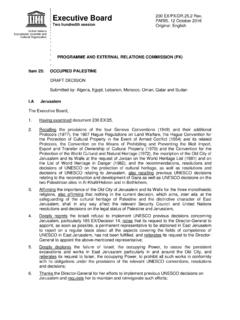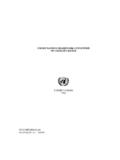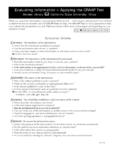Transcription of Some Factors That Hinder Women Participation in …
1 1 Arts and social Sciences Journal, Volume 2010: ASSJ-4 Some Factors that Hinder Women Participation in social , Political and Economic Activities in Tanzania Elisia Losindilo**, AS Mussa*, RRJ Akarro** **Assistant Lecturer, University of Dar es Salaam, Department of Mathematics, PO Box 35062, Dar es Salaam, Tanzania *Senior Lecturer, Department of Statistics, PO Box 35047, Dar es Salaam, Tanzania **Associate Professor, Department of Statistics, PO Box 35047, Dar es Salaam, Tanzania **Correspondence to: RRJ Akarro, Published online: March 14, 2010 Abstract This paper addresses Women s Participation in social , political and economic activities. In particular, Factors that Hinder Women from participating in social , political and economic activities in mainland Tanzania are discussed. Analysis shows that Factors such as level of education, type of place of residence, marital status, religion, region of residence and age groups, with different levels of magnitude contribute differently to their poor Participation .
2 Cross-tabulation is used to establish the relationship between Participation as the dependent variable and the aforementioned Factors . Multiple logistic regressions were used to determine the relative importance of the Factors . Results indicate that place of residence; age group and region of residence are significant while education and religion are insignificant. Keywords: Women Participation ; social ; political; economic; activities; Tanzania. Introduction The reality of the Women of southern Africa, including Tanzania, is that they remain a vulnerable marginalized group that is yet to enjoy equality in status and access to services and resources with their counterparts. Women are found at the bottom rung of poverty, of illiteracy, of landlessness and are concentrated in rural areas where facilities and services are scarce. Women are the most affected by negative impacts of economic adjustment programmes.
3 Cuts in social expenditure such as in health and education mostly affect Women and girls who are victims of the worst forms of violence [1]. The customary laws have given men more power and control over resources and decision-making processes, hence making the system both patriarchal and undemocratic. This has led to widely differing access to resources and decision-making processes, which is partly the reason why Women s socio-economic and political status remain low. Although Women turn up in large numbers in every political election whereby they constitute more than half of the population in many countries, yet they are visibly absent in positions in the Government, parastatal organizations and private companies. Women remain concentrated in the so-called female professions and at the very best in the middle management positions, and hence miss the decision-making processes at higher levels.
4 Thus, Women are grossly under-represented wherever decisions are made, regardless of the level or the institution involved. This is especially true within government machinery despite the fact Tanzania is signatory to many UN conventions and resolutions on gender equality. Women provide major labour input to many economic activities, varying from informal employment to self-employment. Opportunities for Women in the formal sector are very limited due to historical, social , cultural and political Factors . Therefore, most Women are compelled to find employment in the informal sector, which include business in petty trading in urban and rural areas, street trade, food processing, local beer brewing and hair salons. A few employed and unemployed Women become sex workers, usually to supplement their incomes. This paper is aimed 2 Research Article at identifying some Factors that Hinder Women in Participation in social , political and economic activities in Tanzania mainland.
5 This is done with a view of designing programmes that may rectify the situation. Methods The Tanzanian mainland regions are classified into seven geographic zones [2]. The reasons for using zones are that each geographic area will have a relatively large number of cases and sampling errors will thus be reduced. The zones are selected in such a manner that cultural homogeneity is made as close as possible. The zones are defined below:- Western: Tabora, Shinyanga and Kigoma. Northern: Kilimanjaro, Tanga, Arusha and Manyara. Central: Dodoma and Singida. Southern Highlands: Mbeya, Iringa and Rukwa. Lake: Kagera, Mwanza and Mara. Eastern: Dar es salaam, Pwani and Morogoro. Southern: Lindi, Mtwara and Ruvuma. From the seven zones, the study selected the regions, Rukwa, Mwanza and Lindi to represent southern highlands, lake and southern zones respectively. The study, also decided to take Tabora region to represent western and central zones, due to their similar characteristics.
6 Likewise, Dar es Salaam region represented eastern zone. Population of interest was Women aged between 15 and 49 years. Hence, the study used secondary data collected from 2004/05 Tanzania Demographic and Health Survey, [2] a national sample survey of all Women aged 15-49 and all men aged 15-49 years in a sub-sample of one-third of the household who were individually interviewed, and who were either permanent residents of the households or visitors, who were eligible to be interviewed, that were present in the household on the night before the survey. The data were expected to provide sufficient information on the Factors that Hinder Women from participating in social , political and economic activities. A sample of 10,329 Women was obtained in this manner. For a detailed information on data collection procedure by see [2]. Since the dependent variables were dichotomous, logistic regression was used in the analysis.
7 In this study, the dependent variables for the logistic regression analysis were; currently working, selling land without permission, operate her account, knowledge of loan programmes and given loan. These were regarded as proxies to social , political, as well as economic Participation . The dependent variables take a value of 1 when the individual declares that she participates and a value of zero when she does not participate. The independent variables are level of education, place of residence, marital status, religion, region of residence and age group. The logistic regression used was of the form y =Probability (event) =ze 11, where z is the linear combination and is given by z = 0+ 1X1+..+ nXn + , and that X1 ..Xn are independent variables [3]. Cross-tabulation is used to establish the relationship between variables by taking into account observed and expected values.
8 Multiple logistic regressions was used to determine the relative importance of the Factors that Hinder Women s Participation in social , political and economic activities, and to eliminate any that did not contribute significantly to explaining the variance in Participation , once other Factors were taken into account. 3 Arts and social Sciences Journal, Volume 2010: ASSJ-4 Results and Discussion From a sample of 10,329 Women in mainland Tanzania, the study showed that live in rural areas while live in urban areas. Moreover the age distribution showed that a much higher proportion of the population was in the younger age groups. Those aged between 15 and 19 years were , and that 83% were below 40 years of age. The majority of respondents were married ( ), followed by those not in a union ( ) that is, single and were just living with a man. The education level among respondents was very low since the majority ( ) had primary level of education, had secondary level of education and very few ( ) had university level of education.
9 Level of Education Results show that Women with post-secondary training level of education ( ), work more than those with post primary level of education and secondary level of education, ( ) and ( ) respectively. All Women with post-primary training and university levels of education can sell land without permission; while about slightly less than a half of the Women at primary level of education could not do so. The chi-square test has shown significant difference between level of education and selling land without permission (chi-square value: and p value ). On the other hand, there is significant association between level of education and respondents operating an account, with the chi-square test giving a value of and an extreme small asymptotic significant value. A large group comprises of Women with post-primary training, post-secondary training and university levels of education, while Women with primary and secondary levels of education constitute a small group.
10 The results show that Women with pre-school level of education know nothing about loan programmes. Around half of the post-primary trained Women ( ) have knowledge of loan programmes as well as the post-secondary trained ( ). The above test gave the chi-square value of and extreme small asymptotic significant value. It thus shows that the relationship between education levels and Women s knowledge of loan programmes as statistically significant. All Women with pre-school and university levels of education had no any loan. The post-secondary training ( ) and primary level of education ( ) had loans. The chi-square test (with a value of ) has shown significant difference in relationship between education level and Women with a loan. Place of Residence The study shows that ( ) of Women in Lindi Region, ( ) in Rukwa and ( ) in Dar es Salaam are currently working.
